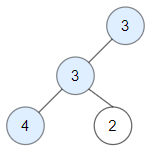Implement the class SubrectangleQueries which receives a rows x cols rectangle as a matrix of integers in the constructor and supports two methods:
1. updateSubrectangle(int row1, int col1, int row2, int col2, int newValue)
- Updates all values with
newValuein the subrectangle whose upper left coordinate is(row1,col1)and bottom right coordinate is(row2,col2).
2. getValue(int row, int col)
- Returns the current value of the coordinate
(row,col)from the rectangle.
Example 1:
Input ["SubrectangleQueries","getValue","updateSubrectangle","getValue","getValue","updateSubrectangle","getValue","getValue"] [[[[1,2,1],[4,3,4],[3,2,1],[1,1,1]]],[0,2],[0,0,3,2,5],[0,2],[3,1],[3,0,3,2,10],[3,1],[0,2]] Output
[null,1,null,5,5,null,10,5]
Explanation SubrectangleQueries subrectangleQueries = new SubrectangleQueries([[1,2,1],[4,3,4],[3,2,1],[1,1,1]]); // The initial rectangle (4×3) looks like: // 1 2 1 // 4 3 4 // 3 2 1 // 1 1 1 subrectangleQueries.getValue(0, 2); // return 1 subrectangleQueries.updateSubrectangle(0, 0, 3, 2, 5); // After this update the rectangle looks like: // 5 5 5 // 5 5 5 // 5 5 5 // 5 5 5 subrectangleQueries.getValue(0, 2); // return 5 subrectangleQueries.getValue(3, 1); // return 5 subrectangleQueries.updateSubrectangle(3, 0, 3, 2, 10); // After this update the rectangle looks like: // 5 5 5 // 5 5 5 // 5 5 5 // 10 10 10 subrectangleQueries.getValue(3, 1); // return 10 subrectangleQueries.getValue(0, 2); // return 5
Example 2:
Input ["SubrectangleQueries","getValue","updateSubrectangle","getValue","getValue","updateSubrectangle","getValue"] [[[[1,1,1],[2,2,2],[3,3,3]]],[0,0],[0,0,2,2,100],[0,0],[2,2],[1,1,2,2,20],[2,2]] Output
[null,1,null,100,100,null,20]
Explanation SubrectangleQueries subrectangleQueries = new SubrectangleQueries([[1,1,1],[2,2,2],[3,3,3]]); subrectangleQueries.getValue(0, 0); // return 1 subrectangleQueries.updateSubrectangle(0, 0, 2, 2, 100); subrectangleQueries.getValue(0, 0); // return 100 subrectangleQueries.getValue(2, 2); // return 100 subrectangleQueries.updateSubrectangle(1, 1, 2, 2, 20); subrectangleQueries.getValue(2, 2); // return 20
Constraints:
- There will be at most
500operations considering both methods:updateSubrectangleandgetValue. 1 <= rows, cols <= 100rows == rectangle.lengthcols == rectangle[i].length0 <= row1 <= row2 < rows0 <= col1 <= col2 < cols1 <= newValue, rectangle[i][j] <= 10^90 <= row < rows0 <= col < cols
Solution 1: Simulation
Update the matrix values.
Time complexity:
Update: O(m*n), where m*n is the area of the sub-rectangle.
Query: O(1)
Space complexity: O(rows*cols)
C++
|
1 2 3 4 5 6 7 8 9 10 11 12 13 14 15 16 17 18 |
// Author: Huahua class SubrectangleQueries { public: SubrectangleQueries(vector<vector<int>>& rectangle): m_(rectangle) {} void updateSubrectangle(int row1, int col1, int row2, int col2, int newValue) { for (int i = row1; i <= row2; ++i) for (int j = col1; j <= col2; ++j) m_[i][j] = newValue; } int getValue(int row, int col) { return m_[row][col]; } private: vector<vector<int>> m_; }; |
Solution 2: Geometry
For each update remember the region and value.
For each query, find the newest updates that covers the query point. If not found, return the original value in the matrix.
Time complexity:
Update: O(1)
Query: O(|U|), where |U| is the number of updates so far.
Space complexity: O(|U|)
C++
|
1 2 3 4 5 6 7 8 9 10 11 12 13 14 15 16 17 18 19 20 |
// Author: Huahua class SubrectangleQueries { public: SubrectangleQueries(vector<vector<int>>& rectangle): m_(rectangle) {} void updateSubrectangle(int row1, int col1, int row2, int col2, int newValue) { updates_.push_front({row1, col1, row2, col2, newValue}); } int getValue(int row, int col) { for (const auto& u : updates_) if (row >= u[0] && row <= u[2] && col >= u[1] && col <= u[3]) return u[4]; return m_[row][col]; } private: const vector<vector<int>>& m_; deque<vector<int>> updates_; }; |





